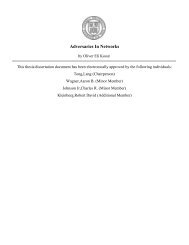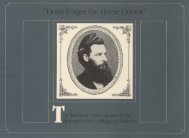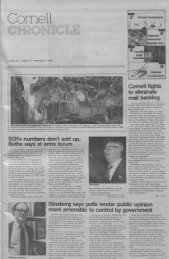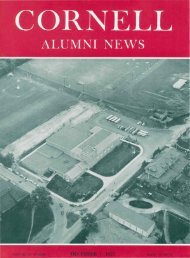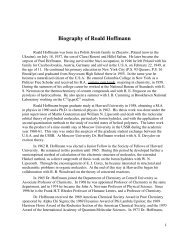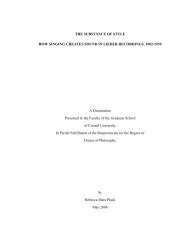Cornell Alumni News - eCommons@Cornell - Cornell University
Cornell Alumni News - eCommons@Cornell - Cornell University
Cornell Alumni News - eCommons@Cornell - Cornell University
You also want an ePaper? Increase the reach of your titles
YUMPU automatically turns print PDFs into web optimized ePapers that Google loves.
• Robert L. Sproull, former director of<br />
the Advanced Research Projects Agency<br />
of the Department of Defense, from<br />
1963-65, is vice president for academic<br />
affairs. He is responsible for the investigation<br />
of <strong>Cornell</strong>'s academic problems<br />
and the instrumentation of their revisions.<br />
A native of Lacon, 111., Professor<br />
Sproull entered Deep Springs College in<br />
California and earned the bachelor of<br />
arts degree from <strong>Cornell</strong> in 1940. In<br />
1943 he was awarded the PhD degree<br />
from <strong>Cornell</strong>, and he spent the following<br />
two years simultaneously working for<br />
the Radio Corporation of America Laboratory<br />
and teaching physics at Princeton<br />
<strong>University</strong>. He then joined the faculty<br />
of <strong>Cornell</strong> as assistant professor of<br />
ROBERT L. SPROULL<br />
physics, rising to the rank of full professor<br />
in 1956.<br />
He spent sabbatical leaves in 1952 as a<br />
physicist at the Oak Ridge National Laboratory<br />
and in 1958-59 with the European<br />
Research Associates in Brussels.<br />
While at Brussels he was also a lecturer<br />
for the North Atlantic Treaty Organization<br />
(NATO).<br />
Professor Sproull has served on various<br />
advisory committees and has been a<br />
consultant to industrial firms. He has<br />
been a member of the Materials Advisory<br />
Board, National Academy of Sciences,<br />
since 1959, and has served on the<br />
Advisory Committee for Solid State<br />
Physics of the Academy. He was named<br />
to the Laboratory Management Council<br />
of the Oak Ridge National Laboratory in<br />
1962, and that same year became a trustee<br />
of Associated Universities, Inc.<br />
From 1954 to 1957, he was editor on<br />
the Journal of Applied Physics. He is trie<br />
author of Modern Physics, a textbook on<br />
the quantum physics of atoms, solids and<br />
nuclei. He has also written numerous<br />
articles for professional journals.<br />
At <strong>Cornell</strong>, he has been director of the<br />
Laboratory of Atomic & Solid State<br />
Physics and of the Materials Science<br />
Center, which he helped to establish.<br />
A member of Phi Beta Kappa, Sigma<br />
Xi and the American Physical Society, he<br />
has been active for many years in<br />
Telluride Association, and he has served<br />
as its president.<br />
There have been some other programs proposed in the past<br />
for which we've sought outside funding, but did not obtain<br />
it. But, we are still working on it.<br />
Q. The new freshman humanities program is a prime<br />
example of innovation in undergraduate instruction, isn't it?<br />
A. Yes. But it is also an area like so many for which the<br />
commission can take very little if any credit. The course<br />
seems to be going very well. As with any educational innovation,<br />
it is relatively easy to keep one's steam up and<br />
spirit up the first year. We all hope that the same spirit will<br />
prevail through subsequent years, but, of course, it's too<br />
early to tell.<br />
Q. What is the content of this new program?<br />
A. The principal change has been that instead of having<br />
one monolithic English course in some one hundred sections,<br />
the entering student is now offered a great variety of<br />
subject matter. There are more than thirty sections of these<br />
courses now so that the student can be working on subjects<br />
of prime interest to him. In the monolithic English course,<br />
content was standardized whether those students or instructors<br />
were interested in that particular area of English<br />
literature or not. The principal purpose has been to introduce<br />
variety, to introduce selection by the students of areas<br />
of interest and to make sure that the staff members teaching<br />
that particular section are in fact interested in that particular<br />
subject matter.<br />
Q. The specific purpose of the former freshman English<br />
course was to teach good writing. Does this purpose still<br />
remain?<br />
A. Yes. Good writing and also a more sophisticated approach<br />
to reading so that students will become more interested<br />
in literature. And it seems to be working. If writing<br />
is better, I guess, in large part it's because the student is<br />
more interested. He now writes on a subject matter of concern<br />
to him and he writes in a field where the class time<br />
has been spent largely in studying the subject matter itself,<br />
Q. Has this new arrangement affected the size of classes?<br />
A. Class size is virtually the same as the sections in the<br />
old course. The individual courses are now much smaller<br />
because there are many more to choose from.<br />
Q. Are there any other innovations planned in these<br />
courses?<br />
A. We have our fingers crossed on the question of<br />
whether remedial writing instruction might not be required.<br />
There is such a course in the College of Agriculture and it<br />
seems to be quite successful. We felt when these humanities<br />
courses began that we might need an escape route for students<br />
who wrote most poorly. However, we have not heard<br />
any great complaint about student writing under the new<br />
setup, but we will keep our antennae out to sense such<br />
problems. There do not seem to be any so far.<br />
Q. A major student complaint in recent years has centered<br />
on class size. Is it a legitimate criticism?<br />
A. The Kahn-Bowers committee was struck by the fact<br />
that sophomores, in particular, had only large classes. We<br />
have not done anything yet to try to cut down the class<br />
size. We have looked at this question and some of the student<br />
members of the commission are still looking into it.<br />
There are two problems here. One involves scheduling and<br />
the other financing. Actually, there are plenty of small<br />
classes, even in the College of Arts and Sciences. The difficulty<br />
is that they are not distributed well. In a subject like<br />
English, for example, which has over 300 majors, there is a<br />
tendency for the upperclass courses to be large in size. The<br />
Classics, with only ten majors, have class sizes which tend<br />
to be very small indeed. If a student feels strongly enough<br />
that he wants personal involvement with professorial staff,<br />
then he should use class size as part of the information<br />
which he considers when he selects a major. He's virtually<br />
22 <strong>Cornell</strong> <strong>Alumni</strong> <strong>News</strong>




